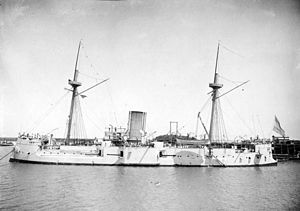
The Indiana-class was a class of three pre-dreadnought battleships launched in 1893. These were the first battleships built by the United States Navy comparable to contemporary European ships, such as the British HMS Hood. Authorized in 1890 and commissioned between November 1895 and April 1896, these were relatively small battleships with heavy armor and ordnance that pioneered the use of an intermediate battery. Specifically intended for coastal defense, their freeboard was insufficient to deal well with the waves of the open ocean. The turrets lacked counterweights, and the main belt armor was placed too low to be effective under most conditions.
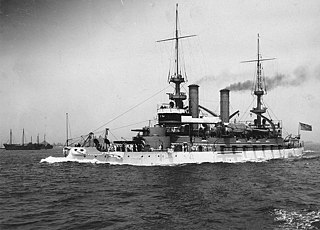
The Kearsarge-class was a group of two pre-dreadnought battleships built for the United States Navy in the 1890s. The two ships—USS Kearsarge and USS Kentucky—represented a compromise between two preceding battleship designs, the low-freeboard Indiana class and the high-freeboard USS Iowa, though their design also incorporated several improvements. Their primary advances over earlier designs consisted of new quick-firing guns and improved armor protection, but their most novel feature was their two-story gun turrets that consisted of a secondary 8-inch (203 mm) gun turret fixed to the top of their primary 13-inch (330 mm) turrets. The ships suffered from a number of problems, however, including a tertiary battery mounted too low in the hull and poorly-designed turrets, though the latter were attempted again with the Virginia class in the early 1900s, also with negative results.

SMS Oldenburg was an armored warship of the Imperial German Navy. Laid down at the AG Vulcan shipyard in Stettin in 1883, the ship was launched in December 1884 and commissioned into the Navy in April 1886. Oldenburg was intended to have been a fifth member of the Sachsen class of sortie corvettes, but budgetary limitations and dissatisfaction with the Sachsen class prompted a redesign that bore little resemblance to the earlier vessels. Oldenburg mounted her main battery of eight 24 cm (9.4 in) guns amidships, six in a central casemate on the main deck and two directly above them on the broadside. She was the first German capital ship constructed entirely from German-made steel.

The Normandie class consisted of five dreadnought battleships ordered for the French Navy in 1912–1913. It comprised Normandie, the lead ship, Flandre, Gascogne, Languedoc, and Béarn. The design incorporated a radical arrangement for the twelve 340 mm (13.4 in) main battery guns: three quadruple-gun turrets, the first of their kind, as opposed to the twin-gun turrets used by most other navies. The first four ships were also equipped with an unusual hybrid propulsion system that used both steam turbines and triple-expansion steam engines to increase fuel efficiency.

Duilio was the lead ship of the Duilio class of ironclad turret ships built for the Italian Regia Marina. Named for the Roman admiral Gaius Duilius, the ship was laid down in January 1873, was launched in May 1876, and was completed in January 1880. She was armed with a main battery of four 450 mm (17.7 in) guns, then the largest gun afloat, and she was capable of a top speed of around 15 knots.
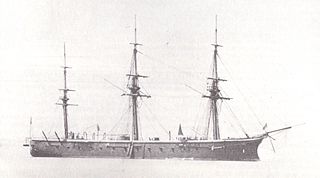
HMS Bellerophon was a central battery ironclad built for the Royal Navy in the mid-1860s.

Enrico Dandolo was the second of two Duilio-class ironclad turret ships built for the Italian Regia Marina in the 1870s. They were fitted with the largest guns available, 450 mm (18 in) rifled, muzzle-loading guns, and were the largest, fastest and most powerful ships of their day. Enrico Dandolo was built in La Spezia, with her keel laid in January 1873 and her hull launched in July 1878. Construction was finally completed in April 1882 when the ship, named for the 41st Doge of Venice, was commissioned into the Italian fleet.

The Hydra class of ironclads composed three ships, Hydra, Spetsai, and Psara. The ships were ordered from France in 1885 during the premiership of Charilaos Trikoupis, as part of a wider reorganization and modernization of the Greek armed forces, which had proved themselves inadequate during the Cretan uprising of 1866. Launched in 1889 and 1890, the ships were ready for service with the Greek Navy by 1892. They were armed with a main battery of three 10.8-inch (274 mm) guns and five 5.9-inch (150 mm) guns, and had a top speed of 17 knots.

The République class consisted of a pair of pre-dreadnought battleships—République, the lead ship, and Patrie—built for the French Navy in the early 1900s. They were ordered as part of a naval expansion program directed at countering German warship construction authorized by the German Naval Law of 1898. The French program called for six new battleships; the last four became the very similar Liberté class. République and Patrie, designed by Louis-Émile Bertin, were a significant improvement over previous French battleships. They carried a similar offensive armament of four 305 mm (12 in) guns and eighteen 164 mm (6.5 in) guns, though most of the 164 mm guns were now mounted in more flexible gun turrets rather than in casemates. They also had a much more effective armor protection arrangement that remedied the tendency of earlier battleships to lose stability from relatively minor damage.

Almirante Cochrane was a central battery ship of the Chilean Navy in the late nineteenth century. She was built, like her twin, Blanco Encalada, in the UK in 1875. She participated in the War of the Pacific, with her most prominent action being her victory over the Peruvian turret ram Huáscar in the Angamos naval battle. Almirante Cochrane was part of the forces that defeated President José Manuel Balmaceda in the Chilean Civil War of 1891.

ARA San Martín was one of four Giuseppe Garibaldi-class armored cruisers purchased by the Argentine Navy from Italy.
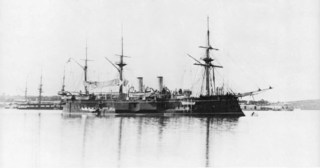
SMS Tegetthoff was an ironclad warship of the Austro-Hungarian Navy. She was built by the Stabilimento Tecnico Triestino shipyard in Trieste, between April 1876 and October 1881. She was armed with a main battery of six 28 cm (11 in) guns mounted in a central-battery. The ship had a limited career, and did not see action. In 1897, she was reduced to a guard ship in Pola, and in 1912 she was renamed Mars. She served as a training ship after 1917, and after the end of World War I, she was surrendered as a war prize to Italy, which sold her for scrapping in 1920.

The Italia class was a class of two ironclad battleships built for the Italian Regia Marina in the 1870s and 1880s. The two ships—Italia and Lepanto—were designed by Benedetto Brin, who chose to discard traditional belt armor entirely, relying on a combination of very high speed and extensive internal subdivision to protect the ships. This, along with their armament of very large 432 mm (17 in) guns, has led some naval historians to refer to the Italia class as prototypical battlecruisers.

The Rivadavia class consisted of two battleships designed by the American Fore River Shipbuilding Company for the Argentine Navy. Named Rivadavia and Moreno after important figures in Argentine history, they were Argentina's entry in the South American dreadnought race and a counter to Brazil's two Minas Geraes-class battleships.
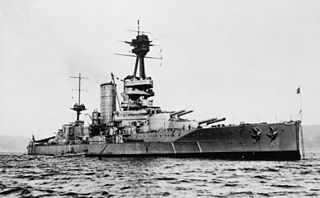
The Almirante Latorre class consisted of two super-dreadnought battleships designed by the British company Armstrong Whitworth for the Chilean Navy. They were intended to be Chile's entries to the South American dreadnought race, but both were purchased by the Royal Navy prior to completion for use in the First World War. Only one, Almirante Latorre (HMS Canada), was finished as a battleship; Almirante Cochrane (HMS Eagle), was converted to an aircraft carrier. Under their Chilean names, they honored Admirals (Almirantes) Juan José Latorre and Thomas Cochrane; they took their British names from what was then a dominion of Canada and a traditional ship name in the Royal Navy.

Capitán Prat was a unique ironclad battleship of the Chilean Navy built in the late 1880s and completed in 1890. Armed with a main battery of four 9.4 in (240 mm) guns in four single turrets, Capitán Prat was the first battleship in the world to be equipped with an electrical system. She was built in the La Seyne dockyard in France, and commissioned into the Chilean fleet in 1891. Foreign navies tried to purchase the ship twice before the outbreak of wars, including an American attempt in 1898 and a Japanese offer in 1903.

The Duilio class was a pair of ironclad turret ships built for the Royal Italian Navy in the 1870s and 1880s. The two ships, Duilio and Enrico Dandolo, were fitted with the largest guns available, 450 mm (17.7 in) rifled muzzle-loading guns, and were the largest, fastest and most powerful ships of their day. To save weight on such large vessels, the ship's designer, Benedetto Brin adopted a radical solution for the time: he reserved armor only for the central portion of the ship where it protected the ships' engines and ammunition magazines, while the rest of the hull were extensively sub-divided with watertight compartments.

ARA Libertad was a battleship that served in the Argentine Navy between 1892 and 1947, and with the Argentine Coast Guard as a pilot station ship from 1947 to 1968. It was the seventh Argentine naval ship with this name.

ARA Independencia was a battleship that served in the Argentine Navy between 1893 and 1948, and with the Argentine Coast Guard as a pilot station ship from 1949 to 1968. It was one of nine Argentine naval ships bearing this name.
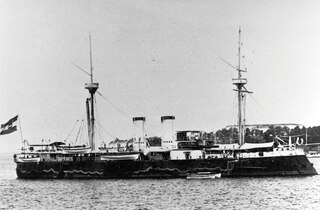
SMS Kronprinzessin Erzherzogin Stephanie was an ironclad warship built for the Austro-Hungarian Navy in the 1880s, the last vessel of that type to be built for Austria-Hungary. The ship, named for Archduchess Stephanie, Crown Princess of Austria, was laid down in November 1884, was launched in April 1887 and completed in July 1889. She was armed with a pair of 30.5-centimeter (12 in) guns in open barbettes and had a top speed of 17 knots. Her service was limited, in large part due to the rapid pace of naval development in the 1890s, which quickly rendered her obsolescent. As a result, her career was generally limited to routine training and the occasional visit to foreign countries. In 1897, she took part in an international naval demonstration to force a compromise over Greek and Ottoman claims to the island of Crete. Kronprinzessin Erzherzogin Stephanie was decommissioned in 1905, hulked in 1910, and converted into a barracks ship in 1914. After Austria-Hungary's defeat in World War I, the ship was transferred to Italy as a war prize and was eventually broken up for scrap in 1926.
